-
 Want to Pamper Your Taste-Buds this Pongal? Here are Mouth-Watering Pongal Recipes You can't Miss in 2019
Want to Pamper Your Taste-Buds this Pongal? Here are Mouth-Watering Pongal Recipes You can't Miss in 2019
-
 भारतीयों का मिठाई के लिए एक विशेष झुकाव है: 10 सबसे स्वादिष्ट भारतीय मिठाइयाँ विकल्प जिन्हे देख कर आपके मुंह में पानी आ जायेगा (2019)
भारतीयों का मिठाई के लिए एक विशेष झुकाव है: 10 सबसे स्वादिष्ट भारतीय मिठाइयाँ विकल्प जिन्हे देख कर आपके मुंह में पानी आ जायेगा (2019)
-
 क्या आप नवरात्रि के लिए उपवास कर रहे हैं? यहां आपके लिए 9 नवरात्रि व्यंजन बनाने की विधि है जो आपके लिए शुद्ध, स्वादिष्ट और स्वस्थ की गारंटी है (2020)
क्या आप नवरात्रि के लिए उपवास कर रहे हैं? यहां आपके लिए 9 नवरात्रि व्यंजन बनाने की विधि है जो आपके लिए शुद्ध, स्वादिष्ट और स्वस्थ की गारंटी है (2020)
Makar Sankranti: Festival of Kites

In India, the most common thing you will see on Makar Sankranti is people flying kites. The sky looks beautiful and colourful filled with kites in different shapes and sizes. It is a fun activity in which you must compete with your friend or neighbour or any of the family member in flying a kite. The one who cuts the kite first or cuts the maximum kites becomes the winner. This fun activity is also beneficial to health. Like we all know Sun is a good source of Vitamin D and flying kites in early morning Sun is considered healthy as it is not only a good source of Vitamin D but is also good for skin and keeps your body away from illness.
Regional Variations of Makar Sankranti
Makar Sankranti
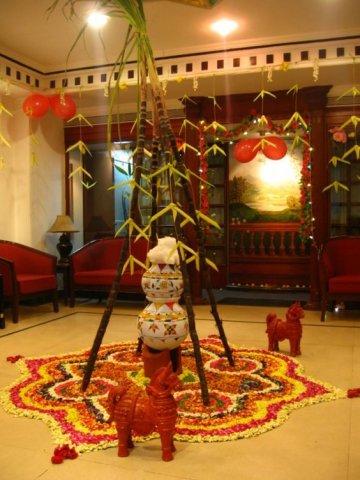
Makar Sankranti is celebrated across India with different names in different regions. In Maharashtra, it is called Makar Sankranti. On this day people with Marathi mother tongue exchanges sweets and Laddoo. The famous dish they prepare on the day is Til Gul. They greet each other with words- "तिळगुळ घ्या, आणि गोड-गोड बोला'' which means have the sweet and speak sweet words. It is also considered an act of forgiving and to remain friends. Even if there is an issue on this day people forget all their rivalry and come together. In some parts of Maharashtra, Makar Sankranti is celebrated in three days- the first day is known as Bhogi in which the Sun God is worshipped. The second day is known as Sankranti. On this day the women also have their traditional program known as Haldi- Kumkum at their houses. The third day is getting together day known as Kinkrat.
Uttarayan

In Gujarat, Makar Sankranti is known as Uttarayan. There cannot be a better place to celebrate Uttarayan other than in the state of Gujarat. People here celebrate the festival with so much zeal and full of enthusiasm. You will start seeing a lot of festive spirit within the people from several days before the festival. Everyone puts a lot of efforts in making and decorating their kites. You will notice that the sky is full of unique kites on the day. They celebrate Uttarayan on two days- 14th and 15th January. They also organise International Kite Festival in which participation of contestants is from across the world. You will hear them shouting "Kai Po Che" from morning to evening while flying kites and end the festival with Chinese Lantern which is lit and left to float in the sky at night.
Pongal
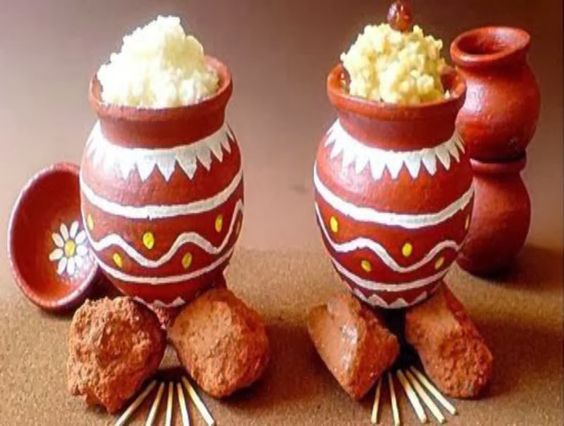
Pongal is the other name of Makar Sankranti celebrated in Tamil Nadu. The meaning of Pongal is "to boil " or "spilling over". Like the name suggests on this day the rice is boiled in a pot until it starts overflowing which is offered on three different days. Pongal is celebrated as the first harvest of the year. It is a three-day festival- on the first day, the Pongal and prayers are offered to Bhogi for supplying rain for the harvest. It is done by lighting the bonfire and putting all useless items as well as cow dung in bonfire which is known as Bhogi Mantalu ritual. On the second day Pongal is offered to Sun God, and on the third day, the Pongal is being provided to cattle in the house.
Top Recipes to Prepare on Makar Sankranti

Makar Sankranti has so many names across India. It is celebrated as Lohri in Punjab, Pongal in South India, Uttarayan in Gujrat, Magh Bihu in Assam and many several names. Like other festivals, on Makar Sankranti, there is the preparation of delicious food. Here are some food recipes that you must try this Makar Sankranti:
Til Laddoo
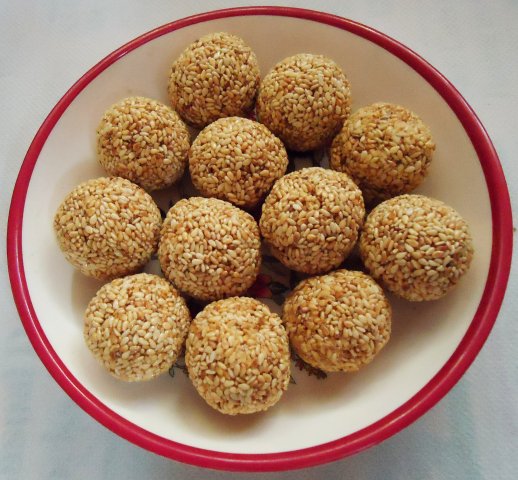
Til Laddoos are healthy and delicious food made from jaggery, sesame seeds, peanuts, and coconuts.
- Step 1. Heat 1/3 cup sesame seeds and 1/4 cup peanuts separately till you see the change in colour on low heat.
- Step 2. Add 1/4 cup desiccated coconut in the pan till it turns golden yellow. Crush the peanuts in the grinder and add to it roasted coconut and sesame seeds. Add 1/4 tbsp of cardamom powder to it and make a mixture.
- Step 3. In the same pan add 1/2 grated jaggery with 3 tbsp of water and keep the pan on low flame. Keep stirring it until it forms a soft ball of jaggery and gives sticky texture.
- Step 4. Switch off the flame and add mixture to the jaggery solution. Keep the pan down when jaggery solution and mixture blends clearly.
- Step 5. Once you take the pan down and the solution is hot, spread some oil on your palm and start making Laddoos out of it. Keep it under a fan for cooling and your til Laddoo snacks are ready.
Peanut Laddoo
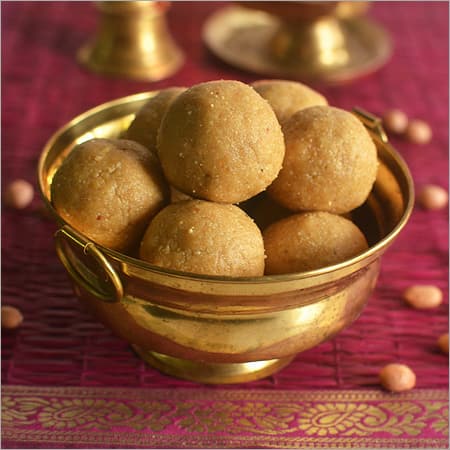
Peanut Laddoo is healthy to eat during winters as it keeps your body warm. It takes only 15 minutes to prepare this mouthful of heaven.
- Step 1. Add raw peanuts to the pan on low flame. Stir it until you see peanuts turning crunchy. Once done rub the peanuts between your palms to remove the peel.
- Step 2. Crush the peanuts in the grinder and add grated jaggery to it. Grind the mixture again till you get a coarse consistency.
- Step 3. Take the mixture in a pan or tray. Take some mixture between your palms and start forming the shape of a ball. let it cool down and your Laddoos are ready to eat.
Murmura Chikki
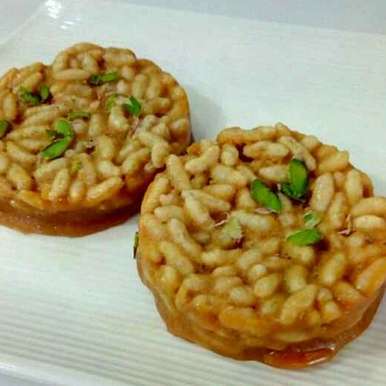
Murmura Chikki is a delicious and quick Maharashtrian snack. All you need is two ingredients to prepare it.
- Step 1. Take a pan and add 3 cups of Murmura to it. Stir it for 3 mins until the colour turns light pink and keep it aside.
- Step 2. Add 2 tbsp of water and jaggery in a pan. Heat it on low flame for 2 minutes and stir continuously.
- Step 3. Add the roasted murmura to the jaggery mixture at once and mix it well.
- Step 4. Take a rectangle pan or tray and brush oil to its surface. Add the mixture to the pan and press the mixture down in the pan shape.
- Step 5. Let it sit for 60 minutes and then with sharp knife start cutting blocks in the mixture.
Badam Suji Halwa
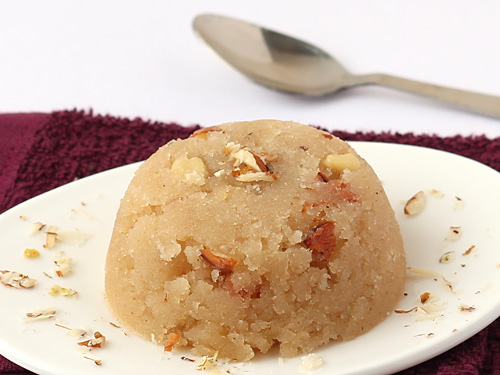
Badam Suji Halwa is star of all Indian festivals. From traditional festivals till events like wedding Badam Suji Halwa is must on the menu.
- Step 1. Roast semolina in a pan for 2 to 3 min on low flame.
- Step 2. Take another pan on a low flame and add ghee. Add crushed almonds and sauté to it. Add milk and keep it on boiling.
- Step 3. Add cardamom powder and sugar to it after few minutes. Add banana slices and salt as well.
- Step 4. Add roasted semolina and keep stirring till the texture becomes thicker. Switch off the gas.
- Step 5. Garnish your halwa and serve ready to eat.
Undhiyu

Undhiyu is made up of seasonal vegetables and served with pooris and roti. Follow the steps to make Undhiyu on this Makar Sankranti.
- Step 1. Make methi muthias by mixing salt and fenugreek leaves with water and soak for 7 to 8 minutes. Squeeze out the water from the leaves and throw away water.
- Step 2. Add whole wheat flour, gram flour, chilli powder, ginger, green chilli paste, a pinch of soda and 11/2 tbsp of olive oil to the leaves. Mix well and add water and knead the mixture into soft dough. Divide the dough into small portions and roll each between the palm in a round shape.
- Step 3. On a non-stick pan heat the oil and keep it on low flame. Fry the muthias when oil is hot till it turns brown in colour and put them on an absorbent paper.
- Step 4. Make slits on the peeled potatoes, eggplants, and slices of bananas. Add chilli powder, sugar, grated coconut, chopped coriander, green chilli paste, green garlic, cumin seed powder, coriander powder, ginger paste, and salt to make coconut-coriander masala. Mix it well and start stuffing in the slits.
- Step 5. Take a large bowl and mix together surti vaal, yam, toor daal and remaining coconut masala and marinate it for 10 minutes.
- Step 6. Add oil in a pressure cooker and heat it on a low flame. Add carom seeds and sauté in the oil until they crackle. Add hing powder and baking soda to it and fry for few seconds. Add stuffed potatoes and eggplants and turn to high flame. Cover the cooker, let there be 2 whistles and then switch the cooker off and let the steam go away.
- Step 7. Open the lid, mix the content in the cooker. Add stuffed bananas with fried muthiyas on top. Once again place the cooker on low flame till the bananas turn tender and soft. Place the dish on a plate and serve hot.
Sweet Pongal
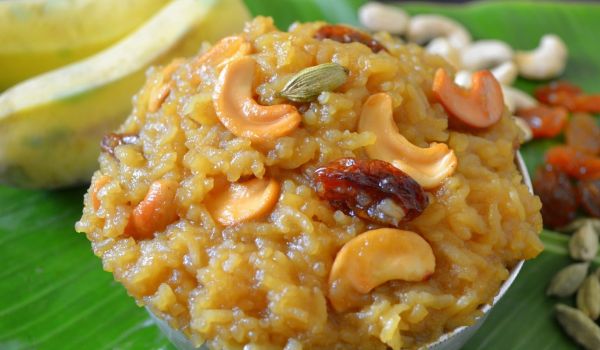
Sweet Pongal is perfect sweet dish to have in menu in any occasion. It is also known as Chakkara Pongal. All you need is little milk and sugar to make sweet pongal on Makar Sankranti.
- Step 1. In a pressure cooker, add moong daal to roast till the dal turns fragrant. Add washed rice to the pan. Add 2 1/
- 4 cups of water and cook it till it softens in a pressure cooker.
- Step 2. In another pan, add grated jaggery and keep it on low flame till the textures become sticky and thick. Once the cooker pressure goes down, open the lid, and mash the rice.
- Step 3. Add jaggery water to the mashed rice and then add green cardamom powder in it. Mix and cook till jaggery water mixes well with rice.
- Step 4. Add ghee and coconut piece to a pan and heat it till it gives an aromatic smell. Add it to the rice.
- Step 5. Add cashews and cloves to a pan on low flame and stir it till it turns golden. Turn off the gas and add raisins and camphor. Mix it well and Sweet Pongal is ready.
Gokul Pithe

Gokul Pithe is a treat of sugar and coconut that melts in your mouth instantly. Here is how you can treat yourself till Makar Sankranti
- Step 1. Make a syrup of two cups of sugar and one cup of water. Let it cool for some time. Heat the pan and add khoya, sugar and sauté to it on medium flame till the textures become thick.
- Step 2. Remove from the heat and allow it cool. Divide it into 8 parts. Roll them into balls and flatten them between your palms.
- Step 3. In a bowl mix maida and sodium bicarbonate. Add one and a half cup of water to create a thick batter coating. Heat ghee in a kadai. Dip the coconut cakes in the maida batter and deep fry till turns golden.
- Step 4. Drain and soak in the sugar syrup for half an hour and it is ready to serve.
Pinni
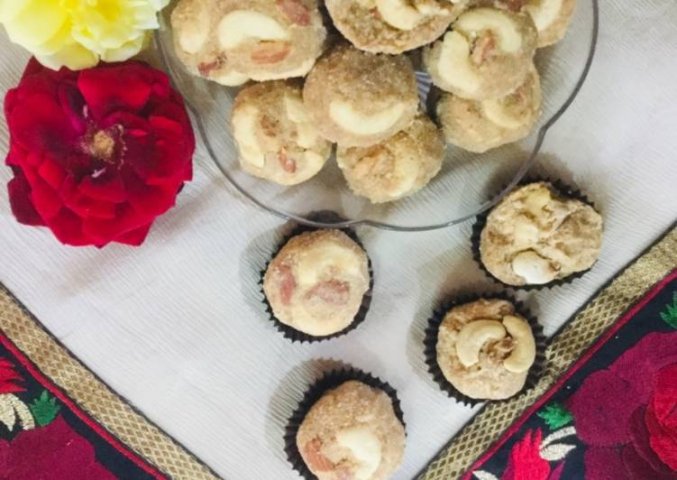
Pinni is a very famous Punjabi dish. As you know Lohri also comes on the same day of Makar Sankranti you can try making Punjabi dish on the day by following steps:
- Step 1: Make a powder of sugar and keep it aside. Heat ghee in a pan. Add flour and mix it until it turns brown. Add khoya and sugar to harden it.
- Step 2: Roast dry Khoya in a vessel until it turns brown. Stir it for around 5 to 6 minutes. Remove the pan from heat and add fried flour.
- Step 3. Add raisin, pistachio, and almonds and keep the mixture to cool.
- Step 4. Pour little milk and mix it. When the mixture is warm start making a ball out it. Decorate it with nuts on top.
Specific Ingredients Used in Recipes
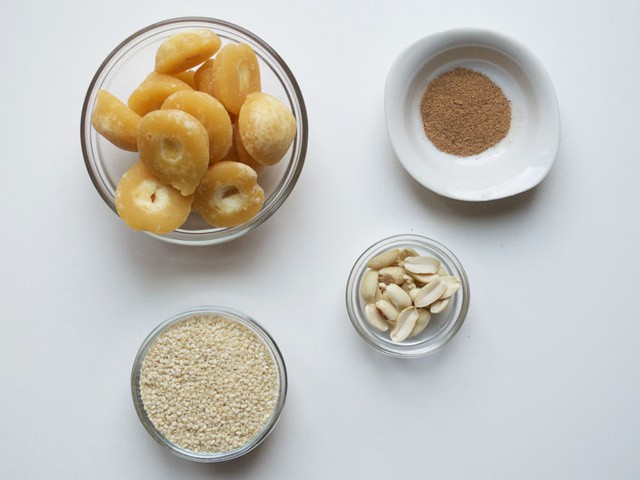
The ingredients in your Sankranti dishes not only adds festive mood but also helps your health. Read below to find out how.
Sesame Seeds

Sesame seeds are main ingredients of Makar Sankranti which add flavour to your Laddoo. But sesame seeds can help you to have a healthy lifestyle. It is good for your skin and hair as it has Vitamin B in it which is important for our body parts. It has minerals like copper and magnesium which is good for people suffering from arthritis and respiratory problems. Eating Sesame Laddoos in the winter season that is exactly when Makar Sankranti is celebrated builds heat in your body to keep your body resistant to winter chills.
Jaggery
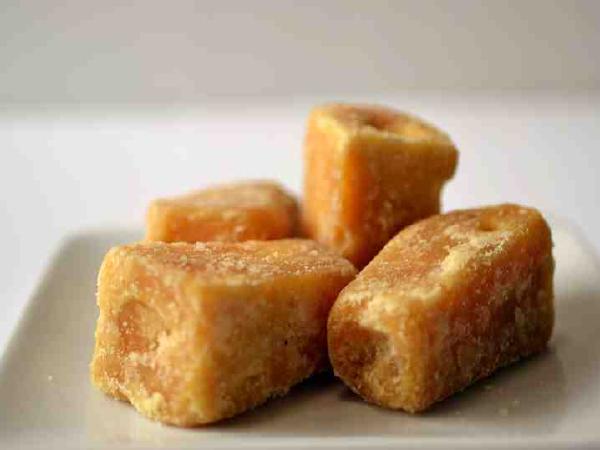
Jaggery adds sweetness to all the sweet dishes made on festivals and any happy events. It also keeps your body fit as it boosts your immunity and detoxifies the body. It is rich in iron so helps to prevent anaemia. During Makar Sankranti, jaggery helps a lot to fight from winter chills as it generates heat inside the body. Jaggery dilates your blood vessels which get constricted in the winter season and improves blood flow.
-
 Want to Pamper Your Taste-Buds this Pongal? Here are Mouth-Watering Pongal Recipes You can't Miss in 2019
Want to Pamper Your Taste-Buds this Pongal? Here are Mouth-Watering Pongal Recipes You can't Miss in 2019
-
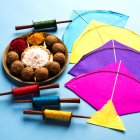 Start This Auspicious Day By Sending Beautiful Makar Sankranti Wishes to Everyone! Festive Greetings, Gifts Ideas and Lots More (2019)
Start This Auspicious Day By Sending Beautiful Makar Sankranti Wishes to Everyone! Festive Greetings, Gifts Ideas and Lots More (2019)
-
 This Festive Season Spread Happiness with 11 Special Diwali Gift Packs (2019)
This Festive Season Spread Happiness with 11 Special Diwali Gift Packs (2019)
-
 भारतीयों का मिठाई के लिए एक विशेष झुकाव है: 10 सबसे स्वादिष्ट भारतीय मिठाइयाँ विकल्प जिन्हे देख कर आपके मुंह में पानी आ जायेगा (2019)
भारतीयों का मिठाई के लिए एक विशेष झुकाव है: 10 सबसे स्वादिष्ट भारतीय मिठाइयाँ विकल्प जिन्हे देख कर आपके मुंह में पानी आ जायेगा (2019)
-
 क्या आप नवरात्रि के लिए उपवास कर रहे हैं? यहां आपके लिए 9 नवरात्रि व्यंजन बनाने की विधि है जो आपके लिए शुद्ध, स्वादिष्ट और स्वस्थ की गारंटी है (2020)
क्या आप नवरात्रि के लिए उपवास कर रहे हैं? यहां आपके लिए 9 नवरात्रि व्यंजन बनाने की विधि है जो आपके लिए शुद्ध, स्वादिष्ट और स्वस्थ की गारंटी है (2020)
Dishes And Desserts Form an Integral Part of Festive Cuisine
Makar Sankranti food has a great significance due to its symbolic value of completion and productivity. It is known by different names. Pongal in Tamil Nadu, Lohri in Punjab, Uttrayan in Gujarat, Bhogali Bihu in Assam, essentially all mean to welcome the spring! The name of the festivities celebrated in several states might differ, but delicious food preparation is what they have in common. So prepare something for your loved and dear ones and have the prepared dish together so that after celebration you get quality time to spend with your family and friends. Don’t rush to the markets. Prepare wonderful delights at home and ring in the celebrations with joy. Happy Makar Sankranti everybody.

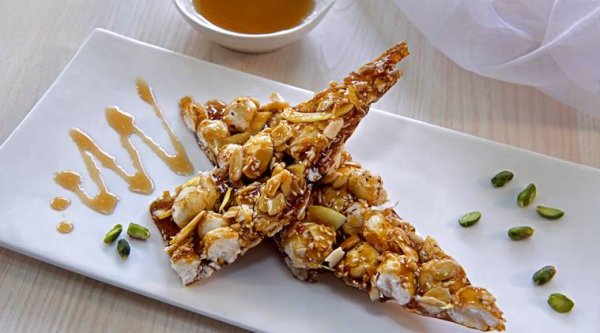
 Highlight the Best Facets of Your Incomparable Beauty: Discover the Best Face Highlighter Currently Available in India and Everything You Need to Know About Using Face Highlighters for Maximum Effect (2023)
Highlight the Best Facets of Your Incomparable Beauty: Discover the Best Face Highlighter Currently Available in India and Everything You Need to Know About Using Face Highlighters for Maximum Effect (2023)
 Forget the Blemishes and Get that Picture Perfect Flawless Radiance on Your Face: Check out the Best Foundations for Oily Skin Currently Available in India and Everything You Need to Know About Makeup Foundations (2023)
Forget the Blemishes and Get that Picture Perfect Flawless Radiance on Your Face: Check out the Best Foundations for Oily Skin Currently Available in India and Everything You Need to Know About Makeup Foundations (2023)
 Make Your Presence Felt Wherever You Go: Discover the Best Perfumes Under 2000 for Both Men and Women to Announce Your Arrival and Make Any Occasion Memorable (2023)
Make Your Presence Felt Wherever You Go: Discover the Best Perfumes Under 2000 for Both Men and Women to Announce Your Arrival and Make Any Occasion Memorable (2023)
 Protect Your Oily Skin from the Harmful Rays of the Sun: Discover the Best Gel Based Sunscreens for Oily Skin and Everything You Need to Know Before Buying One (2023)
Protect Your Oily Skin from the Harmful Rays of the Sun: Discover the Best Gel Based Sunscreens for Oily Skin and Everything You Need to Know Before Buying One (2023)
 Minor Blemishes and Wrinkles Affecting Your Confidence? Check out the Best BB Creams to Conceal Your Worries and Nourish Your Skin to Restore the Healthy, Radiant and Glowing Complexion Back Again (2023)
Minor Blemishes and Wrinkles Affecting Your Confidence? Check out the Best BB Creams to Conceal Your Worries and Nourish Your Skin to Restore the Healthy, Radiant and Glowing Complexion Back Again (2023)
